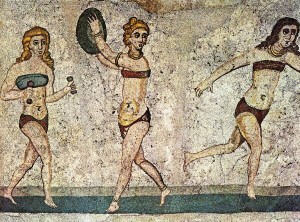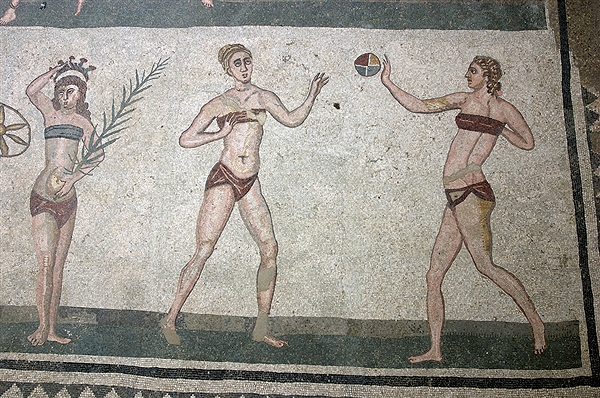by Elizabeth C. Goldsmith (W&M Contributor)
When I was a girl in high school back in the ‘60s, the only team sports available to me were swimming and field hockey. By the time my sister hit high school they had added Cinderella softball and Powder-Puff football. After Title IX, things changed. That’s the modern history of women’s sports.
These thoughts returned to me on a recent trip to Sicily, when I visited the Villa Romana del Casale, a Roman site dating to the early 4th century. It is a grand ruin, the residence of a high-ranking member of the Roman senatorial aristocracy, possibly the governor of the region, which was rediscovered in the late nineteenth century after having been buried in a mudslide that occurred sometime in the 1200s. The dirt and silt had a protective effect, with the result that the mosaics covering the floors of the residence are almost completely intact, making it the largest and best preserved display of ancient Roman mosaics in the world.
There is a grand hallway some 60 meters long covered with mosaics depicting Roman hunters in Africa trapping lions, elephants, rhinoceroses, and tigers and loading them on ships to bring them back to Rome for blood sport entertainment in the Colosseum. There are mosaics depicting amorous mythological scenes in what were the guest bedrooms of the villa, while sea monsters and fishing Cupids adorn the floors of the baths. There is a mosaic of angelic children riding in chariots drawn by ostriches and other birds on the floor of the room that served as a nursery. But the  room that took my breath away was one that might have served as a home gym. It is covered with mosaics of young women engaged in sports, receiving laurel crowns for winning competitions, and just … working out. The images are dubbed “The Bikini Girls” on the museum labels and in guidebooks. I was told that this label is due to the fact that archaeologists in the 1950s thought the mosaics were depicting some kind of beauty contest. They hadn’t ever seen girls lifting weights and wearing sports bras. In the last few years commentators have been trying to revise the label and call the mosaics “The Athletic Girls”.
room that took my breath away was one that might have served as a home gym. It is covered with mosaics of young women engaged in sports, receiving laurel crowns for winning competitions, and just … working out. The images are dubbed “The Bikini Girls” on the museum labels and in guidebooks. I was told that this label is due to the fact that archaeologists in the 1950s thought the mosaics were depicting some kind of beauty contest. They hadn’t ever seen girls lifting weights and wearing sports bras. In the last few years commentators have been trying to revise the label and call the mosaics “The Athletic Girls”.
The Villa Romana del Casale was designated a Unesco World Heritage Site in 1997, a few years after another important Unesco document was released, designating the practice of physical fitness and access to sports a basic human right. We don’t normally associate 4th-century Rome with women’s freedom, but when it came to athletic opportunities for girls – well, some girls -, they were ahead of the game.

